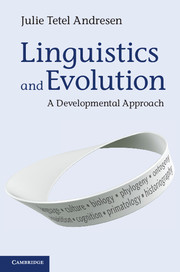Description
Linguistics and Evolution
A Developmental Approach
Author: Tetel Andresen Julie
Linguistics and Evolution offers readers the first rethinking of an introductory approach to linguistics since Leonard Bloomfield's 1933 Language.
Language: English
Subject for Linguistics and Evolution:
Approximative price 43.23 €
In Print (Delivery period: 14 days).
Add to cart
Linguistics and Evolution
Publication date: 11-2013
313 p. · 15.3x22.7 cm · Paperback
Publication date: 11-2013
313 p. · 15.3x22.7 cm · Paperback
Approximative price 89.58 €
In Print (Delivery period: 14 days).
Add to cart
Linguistics and Evolution
Publication date: 11-2013
316 p. · 15.2x22.9 cm · Hardback
Publication date: 11-2013
316 p. · 15.2x22.9 cm · Hardback
Description
/li>Contents
/li>Biography
/li>
Evolutionary linguistics - an approach to language study that takes into account our origins and development as a species - has rapidly developed in recent years. Informed by the latest findings in evolutionary theory, this book sets language within the context of human biology and development, taking ideas from fields such as psychology, neurology, biology, anthropology, genetics and cognitive science. By factoring an evolutionary and developmental perspective into the theoretical framework, the author replaces old questions - such as 'what is language?' - with new questions, such as 'how do living beings become 'languaging' living beings?' Linguistics and Evolution offers readers the first rethinking of an introductory approach to linguistics since Leonard Bloomfield's 1933 Language. It will be of significant interest to advanced students and researchers in all subfields of linguistics, and the related fields of biology, anthropology, cognitive science and psychology.
Introduction: historiography's contribution to theoretical linguistics; Part I. Theoretical Considerations: 1. Language languaging; 2. Developmental systems theory; 3. A twist in the cognitive turn; Part II. A Developmental Systems Linguistics: 4. Evolutionary scenarios I, the standard story and the self-reproductionist script; 5. Evolutionary scenarios II, the emerging story and the self-realizationist script; 6. The ontogenic script begins; 7. The ontogenic script continues; Part III. What To Do Next: 8. Revisit, Skinner, Chomsky and construction grammar; 9. Revise, introductory linguistics textbooks.
Julie Tetel Andresen is Associate Professor in the Department of English at Duke University.
© 2024 LAVOISIER S.A.S.




